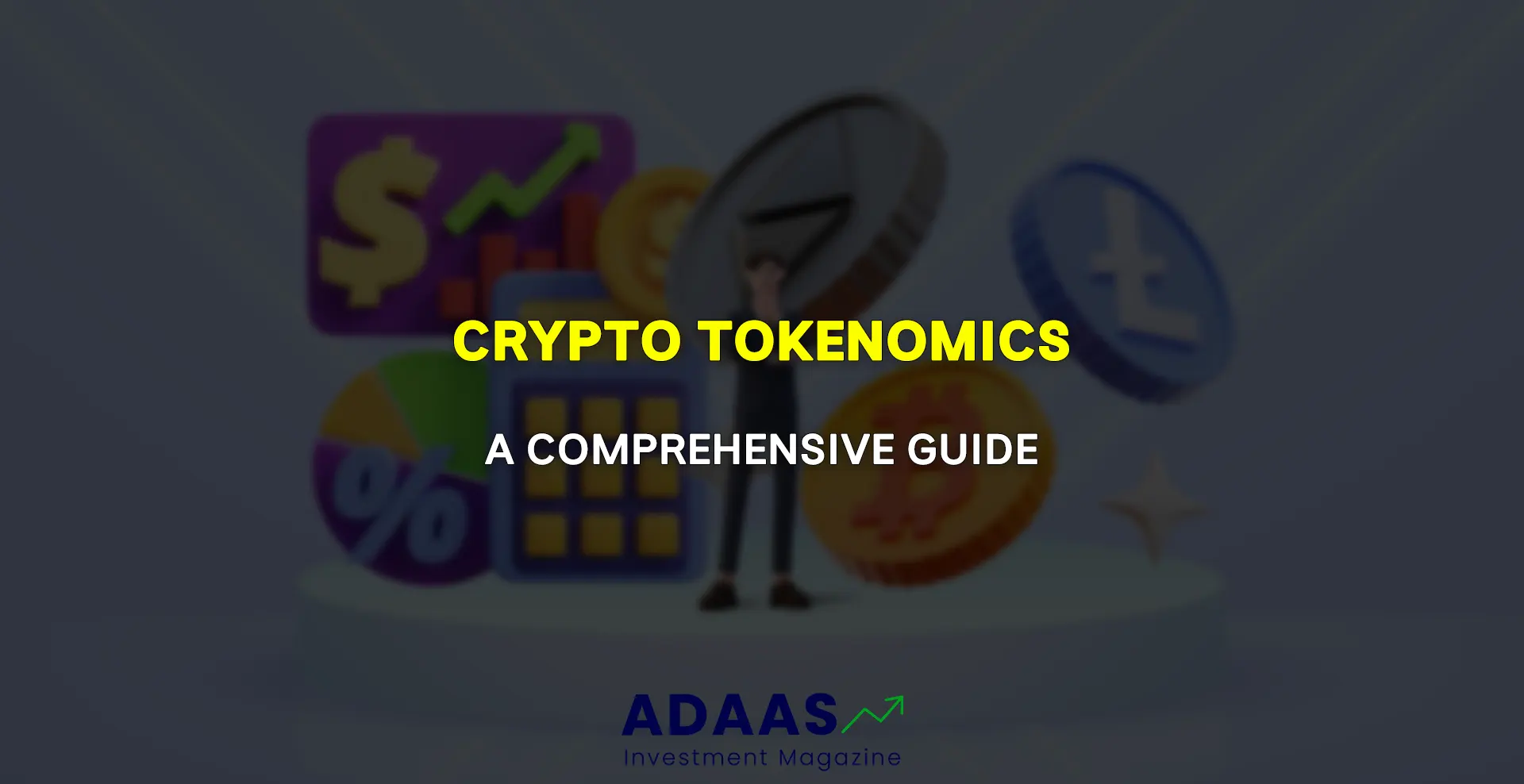What is Tokenomics? How Crypto Economics Works?
Demystifying the World of Tokens in Blockchain and Cryptocurrency
By reading the article “What is Tokenomics” published in Adaas Investment Magazine, you will be fully familiar with the core principles of tokenomics, how tokens drive blockchain ecosystems, and their role in shaping the future of finance. This level of familiarity can be enough when you need educational information about this topic.
Imagine a world where money is not controlled by governments or banks, but by a decentralized network of computers. This is the world of blockchain and cryptocurrencies.
But how do cryptocurrencies derive their value?
This is where tokenomics comes in. Tokenomics is the study of the economic properties of token-based systems. It encompasses a wide range of factors, including token supply, distribution, utility, and value.
Why is tokenomics important?
Understanding tokenomics is crucial for crypto investors, blockchain developers, and anyone interested in the crypto industry. By understanding the tokenomics of a project, investors can assess its long-term potential and identify potential risks. Blockchain developers can use tokenomics to design new projects that are attractive to users and incentivize participation. And anyone interested in the crypto industry can better navigate the complex and ever-changing crypto landscape by understanding the basics of tokenomics.
In this post, we will explore the world of tokenomics and explain what it is, why it is important, and how it is used in the blockchain and crypto space.
Table of Contents
What is tokenomics?
Tokenomics is the study of the economic properties of token-based systems. It encompasses a wide range of factors, including token supply, distribution, utility, and value. Tokenomics is essential for understanding the value of cryptocurrencies and how they function within blockchain ecosystems.
Token types
There are three main types of tokens in the crypto world: utility tokens, security tokens, and governance tokens.
Utility tokens: Utility tokens are used to access products or services within a blockchain ecosystem. For example, Binance Coin (BNB) is a utility token that can be used to pay for transaction fees on the Binance exchange.
Security tokens: Security tokens represent ownership of an underlying asset, such as a company’s shares or a piece of real estate. Security tokens are subject to securities regulations and can be used to raise capital for blockchain projects.
Governance tokens: Governance tokens give holders the right to vote on changes to a blockchain project. For example, Uniswap (UNI) is a governance token that allows holders to vote on changes to the Uniswap decentralized exchange.
Token utility
Tokens are used within blockchain ecosystems for a variety of purposes, including:
– Payments: Tokens can be used to make payments within blockchain ecosystems. For example, Bitcoin (BTC) is a cryptocurrency that can be used to purchase goods and services from merchants who accept it.
– Access to services: Tokens can be used to access products and services within blockchain ecosystems. For example, Filecoin (FIL) is a cryptocurrency that can be used to store files on the Filecoin decentralized storage network.
– Governance: Tokens can be used to participate in the governance of blockchain projects. For example, Aave (AAVE) is a governance token that allows holders to vote on changes to the Aave lending protocol.
Crypto utility
Crypto utility is the use of tokens to access products or services within blockchain ecosystems. Crypto utility is one of the key factors that drives the value of cryptocurrencies.
For example, the value of Binance Coin (BNB) is driven by its utility as a payment method for transaction fees on the Binance exchange. The more users who use BNB to pay transaction fees, the more valuable BNB becomes.
Blockchain economics
Blockchain economics is the study of the economic incentives that drive the behavior of participants in blockchain networks. Tokenomics plays a vital role in blockchain economics, as it determines the supply, distribution, and utility of tokens.
For example, the Bitcoin tokenomics model is designed to incentivize miners to verify transactions and secure the Bitcoin network. By mining Bitcoin, miners earn rewards in the form of BTC. This incentive system helps to ensure that the Bitcoin network remains secure and decentralized.
Tokenomics is a complex and evolving field, but it is essential for understanding the value of cryptocurrencies and how they function within blockchain ecosystems. By understanding the basics of tokenomics, crypto investors, blockchain developers, and anyone interested in the crypto industry can better navigate the complex and ever-changing crypto landscape.
Components of Tokenomics
Tokenomics is a complex and multifaceted field, but it can be broken down into three key components: supply and distribution, use cases, and token value.
Supply and distribution
The supply of a token refers to the total number of tokens that will ever be created. The distribution of a token refers to how the tokens are allocated to different stakeholders.
For example, Bitcoin has a fixed supply of 21 million tokens. The distribution of Bitcoin is decentralized, with no single entity controlling a majority of the tokens.
Other cryptocurrencies may have different supply and distribution models. For example, some cryptocurrencies have a limited supply but are controlled by a central authority. Other cryptocurrencies may have an unlimited supply or be distributed through a variety of mechanisms, such as airdrops or rewards for participation in the network.
Use cases
The use cases of a token refer to the different ways that the token can be used. For example, Bitcoin can be used to make payments, store value, and invest in other cryptocurrencies.
Other tokens may have more specific use cases. For example, some tokens are used to access decentralized applications (dApps), while others are used to participate in governance or yield farming.
The use cases of a token are important for determining its value. A token with more use cases is generally more valuable than a token with fewer use cases.
Token value
The value of a token is determined by a number of factors, including supply and demand dynamics, utility, and investor sentiment.
Supply and demand dynamics are important for determining the price of a token. A token with a limited supply and high demand is generally more valuable than a token with a large supply and low demand.
The utility of a token is also important for determining its value. A token with more use cases is generally more valuable than a token with fewer use cases.
Finally, investor sentiment also plays a role in determining the value of a token. If investors are bullish on a particular token, its price will tend to rise. Conversely, if investors are bearish on a particular token, its price will tend to fall.
The supply and distribution, use cases, and token value are all essential components of tokenomics. By understanding these components, crypto investors, blockchain developers, and anyone interested in the crypto industry can better navigate the complex and ever-changing crypto landscape.
Tokenomics Models
Tokenomics models can vary widely depending on the specific blockchain project or use case. However, some of the most common tokenomics models include:
Bitcoin tokenomics
Bitcoin’s tokenomics model is characterized by its limited supply and its use as digital gold. Bitcoin has a fixed supply of 21 million tokens, which means that there will never be more than 21 million Bitcoin in existence. This limited supply is one of the factors that gives Bitcoin its value.
Bitcoin is also used as digital gold. Digital gold is a term used to describe assets that have similar properties to gold, such as scarcity, durability, and portability. Bitcoin’s limited supply and its ability to be stored and transferred securely make it a popular choice for digital gold.
Ethereum tokenomics
Ethereum’s tokenomics model is different from Bitcoin’s in a few ways. First, Ethereum does not have a fixed supply of tokens. Instead, new Ether (ETH) tokens are created through a process called staking.
Second, ETH is used for more than just payments and storing value. ETH is also used to pay gas fees, which are transaction fees on the Ethereum network. Gas fees are paid to miners who process and verify transactions on the network.
Finally, ETH is used to participate in the governance of the Ethereum network. ETH holders can vote on changes to the Ethereum protocol and participate in decentralized autonomous organizations (DAOs).
DeFi tokenomics
Decentralized finance (DeFi) projects often have complex tokenomics models. DeFi tokens are often used for a variety of purposes, such as lending, borrowing, and yield farming.
For example, the Aave DeFi lending protocol has two tokens: AAVE and LEND. AAVE is a governance token that allows holders to vote on changes to the Aave protocol. LEND is a utility token that is used to pay interest on loans and earn rewards for providing liquidity to the protocol.
Other tokenomics models
In addition to the tokenomics models discussed above, there are a number of other tokenomics models that are used in the blockchain industry. Some of these other models include:
– Security tokens: Security tokens represent ownership of an underlying asset, such as a company’s shares or a piece of real estate. Security tokens are subject to securities regulations and can be used to raise capital for blockchain projects.
– Non-fungible tokens (NFTs): NFTs are unique digital assets that are stored on a blockchain. NFTs can be used to represent ownership of a wide variety of assets, such as digital art, collectibles, and in-game items.
– Social tokens: Social tokens are tokens that are created and distributed by communities. Social tokens can be used to reward active members of a community, give community members access to exclusive content or services, or vote on decisions that affect the community.
Tokenomics is a complex and evolving field, but it is essential for understanding the value of cryptocurrencies and how they function within blockchain ecosystems. By understanding the different tokenomics models that are used, crypto investors, blockchain developers, and anyone interested in the crypto industry can better navigate the complex and ever-changing crypto landscape.
Tokenomics in ICOs and Token Sales
Initial coin offerings (ICOs) are a way for blockchain projects to raise capital by selling tokens to investors. ICOs were popular in 2017 and 2018, but they have since declined in popularity due to a number of factors, including regulatory scrutiny and fraudulent ICOs.
In an ICO, a project creates and sells its own cryptocurrency to investors. The cryptocurrency is typically used to fund the project’s development and to give investors access to the project’s products or services.
Token sale process
The token sale process typically involves the following steps:
1- The project team creates a whitepaper that outlines the project’s vision, roadmap, and tokenomics.
2- The project team launches a website and social media accounts to promote the ICO.
3- The project team creates a token wallet and publishes the wallet address on the project’s website.
4- The project team sets a minimum funding goal and a deadline for the ICO.
5- Investors send cryptocurrency to the project’s token wallet to purchase tokens.
6- After the ICO ends, the project team distributes tokens to investors according to their contributions.
Role of tokens in raising capital
Tokens play a vital role in raising capital for blockchain projects. Tokens give investors a stake in the project and the potential to profit from the project’s success.
Tokens can also be used to access the project’s products or services. For example, investors who purchase tokens in an ICO for a decentralized exchange may be able to use those tokens to pay for trading fees on the exchange.
Security tokens
Security tokens are tokens that represent ownership of an underlying asset, such as a company’s shares or a piece of real estate. Security tokens are subject to securities regulations and can be used to raise capital for blockchain projects.
The tokenomics of security tokens are similar to the tokenomics of traditional securities. Security tokens typically have a fixed supply and are distributed to investors according to their investment amount.
Utility tokens
Utility tokens are tokens that are used to access specific products or services within blockchain ecosystems. For example, Binance Coin (BNB) is a utility token that can be used to pay for transaction fees on the Binance exchange.
The tokenomics of utility tokens can vary widely depending on the specific project. Some utility tokens have a fixed supply, while others have an unlimited supply. Utility tokens can also be distributed to users in a variety of ways, such as through airdrops, rewards for participation in the network, or by purchasing them on exchanges.
Tokenomics is a complex and evolving field, but it is essential for understanding the value of cryptocurrencies and how they function within blockchain ecosystems. By understanding the tokenomics of ICOs and token sales, crypto investors, blockchain developers, and anyone interested in the crypto industry can better navigate the complex and ever-changing crypto landscape.
Challenges in Tokenomics
Tokenomics is a complex and evolving field, and there are a number of challenges that need to be addressed for it to reach its full potential. Some of the most common challenges in tokenomics include:
Regulatory uncertainty: The regulatory landscape for cryptocurrencies and token-based systems is still evolving. This uncertainty can make it difficult for blockchain projects to design tokenomics models that are compliant with all applicable regulations.
Market volatility: The cryptocurrency market is known for its volatility. This can make it difficult to price tokens and to assess their long-term value.
Token manipulation: Token manipulation is the practice of artificially inflating or deflating the price of a token. Token manipulation can be done through a variety of methods, such as wash trading and pump-and-dump schemes.
Future Trends in Tokenomics
Despite the challenges, the future of tokenomics is bright. There are a number of upcoming trends that are likely to shape the development of tokenomics in the coming years. Some of the most notable trends include:
The rise of NFTs: NFTs are unique digital assets that are stored on a blockchain. NFTs can be used to represent ownership of a wide variety of assets, such as digital art, collectibles, and in-game items. The rise of NFTs is likely to lead to new and innovative tokenomics models.
The growth of DAOs: DAOs are organizations that are governed by smart contracts. DAOs can be used to coordinate a variety of activities, such as fundraising, investing, and managing projects. The growth of DAOs is likely to lead to new and more complex tokenomics models.
The integration of tokens in traditional finance: Traditional financial institutions are increasingly exploring the potential of tokens. For example, some banks are developing tokenized versions of their products and services. The integration of tokens in traditional finance is likely to lead to new and more sophisticated tokenomics models.
Tokenomics is a rapidly evolving field with the potential to revolutionize the way we think about value and exchange. By understanding the challenges and future trends in tokenomics, crypto investors, blockchain developers, and anyone interested in the crypto industry can better prepare for the future.
Conclusion
Tokenomics is the study of the economic properties of token-based systems. It is a complex and evolving field, but it is essential for understanding the value of cryptocurrencies and how they function within blockchain ecosystems.
Tokenomics encompasses a wide range of factors, including token supply, distribution, utility, and value. Tokenomics models are used to design and implement token-based systems that are attractive to users and incentivize participation.
Tokenomics is important in the blockchain industry for a number of reasons. First, it helps crypto investors make informed decisions about which cryptocurrencies to invest in. By understanding the tokenomics of a project, investors can assess its long-term potential and identify potential risks.
Second, tokenomics is important for blockchain developers. When designing a new blockchain project, it is essential to carefully consider the tokenomics model. The right tokenomics model can incentivize users to adopt the platform and contribute to its growth.
Finally, tokenomics is important for anyone interested in the crypto industry. By understanding the basics of tokenomics, individuals can better navigate the complex and ever-changing crypto landscape.
Encourage learning
Tokenomics is a rapidly evolving field, so it is important to stay up-to-date with the latest trends and developments. There are a number of resources available to help you learn more about tokenomics, including:
- Online courses and tutorials
- Books and articles
- Industry blogs and podcasts
- Conferences and events
I encourage you to continue learning about tokenomics and to explore the many opportunities that this exciting field has to offer.
Disclaimer: Cryptocurrency investments carry risks. Readers should conduct their own research and consider their risk tolerance before using any exchange.

The End Words
At Adaas Capital, we hope that by reading this article you will be fully immersed in What Is Crypto Tokenomics! You can help us improve by sharing this post which is published in Adaas Investment Magazine and help optimize it by submitting your comments.
FAQ
What is tokenomics in simple words?
In simple words, tokenomics is how tokens are created, used, and valued. It is important to understand the value of cryptocurrencies and how they function within blockchain ecosystems.
What is an example of tokenomics?
Here is an example of tokenomics:
Bitcoin
– Token supply: 21 million tokens, with a fixed supply.
– Token distribution: Bitcoin is mined by individuals and companies, and then distributed to the miners as a reward.
– Token utility: Bitcoin is used as a store of value and medium of exchange.
– Token value: The value of Bitcoin is determined by its supply, demand, and utility.
Bitcoin’s tokenomics model is designed to make it a scarce and valuable asset. The fixed supply and decentralized distribution make Bitcoin attractive to investors. The utility of Bitcoin as a store of value and medium of exchange also contributes to its value.
What is tokenomics in NFT?
NFT tokenomics is the study of how NFTs are created, used, and valued. It is important for understanding the value of NFTs and how they function within blockchain ecosystems. NFT tokenomics is a complex and evolving field, but it is essential for understanding the NFT industry.
What are the benefits of tokenomics?
Tokenomics can incentivize adoption, reduce volatility, and improve transparency of blockchain ecosystems.






